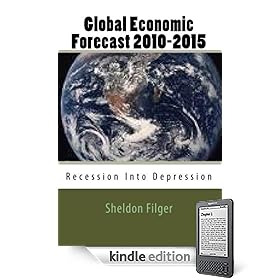There is an old adage which says there exist three types of lies; lies, damn lies and statistics. With that caveat in mind, how should one approach the government’s claim that the U.S. economy contracted by “only” 1% last quarter? The question is of great importance, since this statistical marker underpins the claims being made by legions of politicians and financial analysts that the greatest global recession since the Great Depression is nearing its end, with recovery just around the corner.
Karl Denninger, a frequent guest on CNBC and commentator for a website with a sceptical take on the economy, Market Ticker, has offered a convincing rebuttal to those who stand by the official claim that Q2 witnessed a decline of a mere one percent in the U.S. economy’s GDP. Here are the salient points of Denninger’s critique of the numbers that came out of the Commerce Department’s Bureau of Economic Analysis.
According to the Commerce Department, Q1 was actually significantly worse than the originally reported -5.5%; the actual decline was -6.4%. Due to the different benchmark, the .9% differential needs to be added to the decline in Q2, taking the actual figure to -1.9%. In addition, because the government reduced its spending in Q1 by 4.3%, and comprises approximately 30% of the total economy, its share of Q1 contraction is 1.3%. Here we come to the heart of Denninger’s mathematical analysis. He believes that it is consumer activity that points to the strength or weakness of the American economy, not government spending. Accordingly, he argues that reductions or increases in spending by Washington should be subtracted from quarterly GDP measurements in order to ascertain the actual temperature of the real economy. With that in mind, he backs out the reduction in government spending in Q1, which reduces that quarter’s contraction to just above -5%.
In Q2, Denninger points out, the government’s spending grew by 10.9%, contributing to a positive movement of 3.3% in the second quarter’s reported GDP. Remove that 3.3% from the equation, and the actual Q2 data for the consumer economy witnessed an overall contraction of -5.2%, a figure substantially worse that the official government Q2 report.
The statistical argument raised by Karl Denninger warrants careful consideration by all those who are seeking an accurate gauge of what is actually transpiring in the real economy. Furthermore, the track record of both the Commerce Department and Labor Department has not been exactly stellar with regard to its statistical accuracy in measuring the impact of the Global Economic Crisis on the American economy. Simultaneously with the release of reassuring Q2 numbers, the Commerce Department also admitted it had gotten its evaluation of the recession’s affect on the U.S. economy’s GDP from its onset in Q4 of 2007 through the latter part of 2008 stupendously wrong, now conceding that the actual contraction was -1.9 percent instead of -0.8%, as previously reported.
One other point made by Denninger is especially disturbing. He reminds us that an individual who borrows money from a bank or his/her credit cards would never be able to claim that loaned credit as earned income. Certainly the IRS doesn’t consider credit to be income, or else it would tax us on all our debts. However, in the case of the U.S. government measuring GDP, the opposite logic applies. The increase in government spending in Q2 was predicated entirely on borrowed money, particularly as tax receipts declined significantly even as spending grew in spades. Should money that Washington borrows from its China credit card really be considered part of the GDP`s “growth,” as is now the case?
There is only one flaw with Karl Denninger`s analysis; it is based on logic, a principal that seems irrelevant to any measurement of the economy derived from official government sources.

![TRUMP VERSUS CLINTON: Climactic Struggle For The White House Between Donald Trump And Hillary Clinton by [Filger, Sheldon]](https://images-na.ssl-images-amazon.com/images/I/51-fYOymH8L.jpg)









